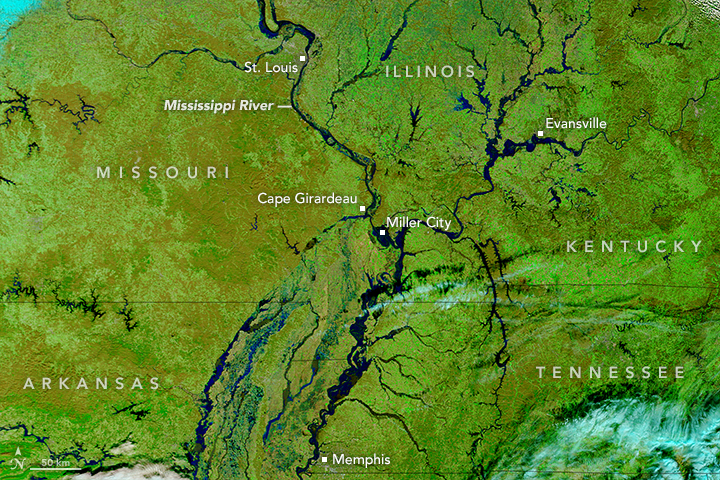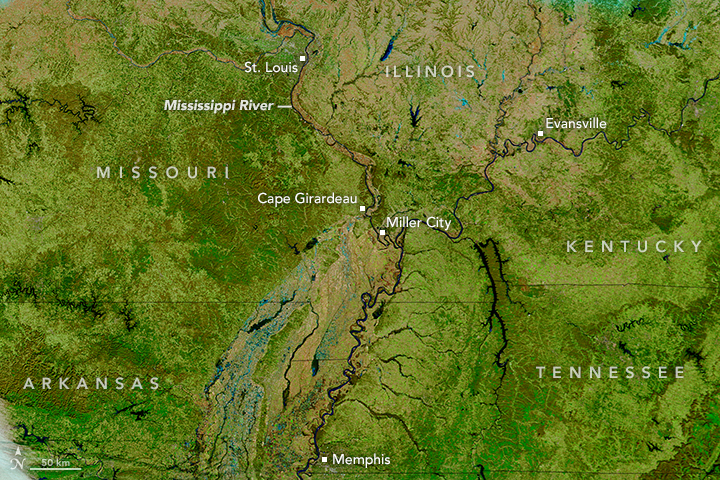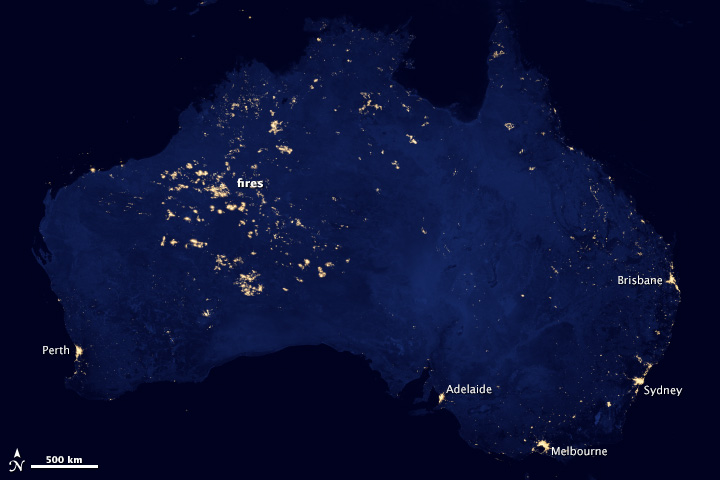Archive for January, 2016
NASA: The Midwest Floods
Saturday, January 9th, 2016
More than a week after heavy rains swamped parts of Missouri and Illinois in December 2015, communities along the Mississippi River are facing severe flooding. The rainfall between December 26–28 dropped at least 6 inches on many communities in an area 50 to 75 miles (80 to 120 kilometers) wide. Some areas saw more than 10 inches (25 centimeters).
On January 1, 2016, the Mississippi River crested at its third highest level on record for St. Louis. By January 2, the surge of water caused the highest flood on record at Cape Girardeau and Thebes, south of St. Louis. At Cape Girardeau, water levels peaked at 48.86 feet (14.89 meters). Above 32 feet is considered flood stage; above 42 feet is major flooding. The previous record was 48.50 feet.
The floodwaters have breached levees in several locations. The most notable breach occurred near Miller City, Illinois, near the confluence of the Mississippi and Ohio rivers. The flood threatened the homes of about 500 people in Olive Branch, Hodges Park, and Unity—nearby towns in Illinois.
On January 3, 2016, the Moderate Resolution Imaging Spectroradiometer (MODIS) on NASA’s Terra satellite acquired this image of flooding along the Mississippi River. For comparison, the second image shows conditions under more typical conditions a year ago on January 10, 2015. The images are composed with false color using a combination of infrared and visible light (MODIS bands 7-2-1). Flood waters appear blue; vegetation is green; and bare ground is brown.
The flood water will continue to move southward in the coming days. Forecasters with the National Weather Service expect the flood will crest in Tiptonville, Tennessee, on January 5; Memphis, Tennessee, on January 8, and Helena, Arkansas, on January 10.
-
References
- Jeff Masters Wunderblog, via Weather Underground (2016, January 4) Historic Mississippi River Flood Brings Highest Crest on Record Below St. Louis. Accessed January 4, 2015.
- National Weather Service, St. Louis (2016) December Historic Rainfall and Flooding Event Review. Accessed January 4, 2016.
- National Weather Service, Memphis (2016) Mississippi River Stages and Crests. Accessed January 4, 2016.
-
Further Reading
- Andrew Revkin’s Dot Earth, via The New York Times (2016, January 4) A Vital Look at Ignored Realities in Midwest Flood Zone. Accessed January 4, 2015.
- The Weather Channel (2016, January 4) Mississippi River Flooding Pushing Downstream; Midwest Begins Cleanup. Accessed January 4, 2015.
NASA image by Jeff Schmaltz, LANCE/EOSDIS Rapid Response. Caption by Adam Voiland.
- Instrument(s):
- Terra – MODIS
Egypt: Two gunmen attempted to storm a resort hotel in the Egyptian coastal city of Hurghada
Saturday, January 9th, 2016
** Three foreign tourists wounded
The global supply of oral cholera vaccines is set to double after WHO approved a third producer from S. Korea
Saturday, January 9th, 2016Cholera vaccine supply set to double, easing global shortage
The global supply of oral cholera vaccines is set to double after WHO approved a third producer, helping to address global shortages and expand access in more countries.

Globally, OCV production is low, with demands currently exceeding supply. Sudan and Haiti last year made requests to WHO for supplies of vaccines to conduct pre-emptive vaccination campaigns that could not be filled because of the global shortage.
The vaccine producer, a South Korean company, is the latest oral cholera vaccine (OCV) manufacturer to be approved under the WHO’s pre-qualification programme, which ensures that drugs and vaccines bought by countries and international procurement agencies such as the United Nations Children’s Fund (UNICEF) meet acceptable standards of quality, safety and efficacy.
The addition of an additional pre-qualified vaccine producer is expected to double global supply to 6 million doses for 2016, with the potential for further increased production in the future. This additional capacity will contribute to reversing a vicious cycle of low demand, low production, high price and inequitable distribution, to a virtuous cycle of increased demand, increased production, reduced price and greater equity of access.
Cholera is an acute diarrhoeal disease that can kill within hours if left untreated. There are between 1.4 million and 4.3 million cases a year, and as many as 142 000 deaths. Cholera is endemic in more than 50 countries, but usually only garners international attention during humanitarian emergencies, such as the outbreak among refugees in Goma, Democratic Republic of the Congo, in 1994 that killed tens of thousands. Climate change and El Niño may also be contributing to more frequent cholera outbreaks.
Oral cholera vaccines have been used in mass vaccination campaigns in response to humanitarian emergencies since 1997. But because the disease disproportionately affects poor communities who are often unaware that the vaccines exist, there has historically been little demand for the products.
In 2013 the WHO created the world’s first OCV stockpile, undertaking to buy and use 2 million doses a year in order to stabilize and create demand for the vaccines.
Vaccination requires 2 doses per person, meaning the stockpile is sufficient to cover 1 million people.
Access to OCV has been further improved by a commitment of US$115 million over 5 years from Gavi, the Vaccine Alliance, to expand availability and the use of vaccine in countries with endemic cholera. Since the OCV stockpile was created more vaccines have been distributed and used than in the previous 15 years. A total of 21 OCV deployments of about 4 million doses to 11 countries have been used in various contexts: humanitarian crises in Cameroon, Haiti, Iraq, Nepal, South Sudan, and United Republic of Tanzania; outbreaks in Guinea and Malawi; and in endemic hotspots such as Bangladesh and Democratic Republic of the Congo.
The creation of the stockpile and pre-qualification of a new vaccine producer highlights the success of an international joint effort through public-private partnership, including governments, non-profit organizations, manufacturers, donors and research organizations. Accompanying the use of stockpile vaccine, many donors and partners have worked together within the framework of the Global Task Force on Cholera Control (GTFCC) to demonstrate the public health potential of this vaccine when used in mass vaccination campaigns. The evidence is contributing to a body of work which will inform larger investments on the further production and use of this vaccine.
** A 6-year-old boy died & his 2 siblings fell ill after eating boiled cassava in a case of suspected food poisoning in Dumanjug town, southwest Cebu.
Saturday, January 9th, 2016References
1. Siritunga D, Sayre RT: Generation of cyanogen-free transgenic
cassava. Planta 2003; 217:367-73.
2. Siritunga D, Arias-Garzon D, White W, Sayre RT: Over-expression of
hydroxynitrile lyase in transgenic cassava roots accelerates
cyanogenesis and food detoxification. Plant Biotechnol 2004; 2:37-43.
CDC: Facts about cyanide: Cyanide is released from natural substances in some foods and in certain plants such as cassava, lima beans and almonds.

Cassava (Manihot esculenta Crantz) is the third most important source of calories in the tropics, after rice and maize. Millions of people depend on cassava in Africa, Asia and Latin America. It is grown by poor farmers, many of them women, often on marginal land. For those people and their families, cassava is vital for both food security and income generation.
But cassava is often seen as a poor cousin in the world’s family of staple crops. While admirably tolerant to drought and productive on poor soils, this hardy tropical root seems unsuited to modern farming. First, it is usually propagated vegetatively from stem cuttings that do not store well and are costly to cut and handle. Vegetative reproduction also means the rate of multiplication of new, improved varieties is slow, retarding their adoption. Harvesting cassava is labour-intensive, and its roots are bulky and highly perishable.
Little wonder, therefore, that cassava is usually grown by poor farmers in marginal areas – and even there, it faces increasing competition as cereals are further improved to adapt them to local conditions. In fact, far less research and development have been devoted to cassava than to rice, maize and wheat. This lack of scientific interest has contributed to highly uneven cultivation and processing methods, and cassava products that often are of poor quality.
The Global Cassava Development Strategy, launched in Rome in 2000, seeks to change all that. At a forum at FAO headquarters, some 80 agricultural experts from 22 countries were asked whether cassava had the potential not only to meet the food security needs of the estimated 500 million farmers who grow it, but to provide a key to rural industrial development and higher incomes for producers, processors and traders.
The forum’s conclusion: cassava could become the raw material base for an array of processed products that will effectively increase demand for cassava and contribute to agricultural transformation and economic growth in developing countries.
two quakes, measured at magnitudes 4.7 and 4.8, struck at 11:27 p.m. Wednesday night in rural northern Oklahoma, directly beneath a major oil and gas production area.
Friday, January 8th, 2016“…..Virtually all the quakes are the result of slippage in faults that have effectively been lubricated by watery wastes from oil and gas production that have been pumped underground…..”
An major bushfire in western Australia destroyed nearly 100 homes and left three people unaccounted for
Friday, January 8th, 2016Extreme Weather & Crop Production
Friday, January 8th, 2016Influence of extreme weather disasters on global crop production
- Journal name: Nature; Volume: 529, Pages: 84–87
- Date published: 07 January 2016
- DOI: doi:10.1038/nature16467
In recent years, several extreme weather disasters have partially or completely damaged regional crop production1, 2, 3, 4, 5. While detailed regional accounts of the effects of extreme weather disasters exist, the global scale effects of droughts, floods and extreme temperature on crop production are yet to be quantified. Here we estimate for the first time, to our knowledge, national cereal production losses across the globe resulting from reported extreme weather disasters during 1964–2007. We show that droughts and extreme heat significantly reduced national cereal production by 9–10%, whereas our analysis could not identify an effect from floods and extreme cold in the national data. Analysing the underlying processes, we find that production losses due to droughts were associated with a reduction in both harvested area and yields, whereas extreme heat mainly decreased cereal yields. Furthermore, the results highlight ~7% greater production damage from more recent droughts and 8–11% more damage in developed countries than in developing ones. Our findings may help to guide agricultural priorities in international disaster risk reduction and adaptation efforts.







